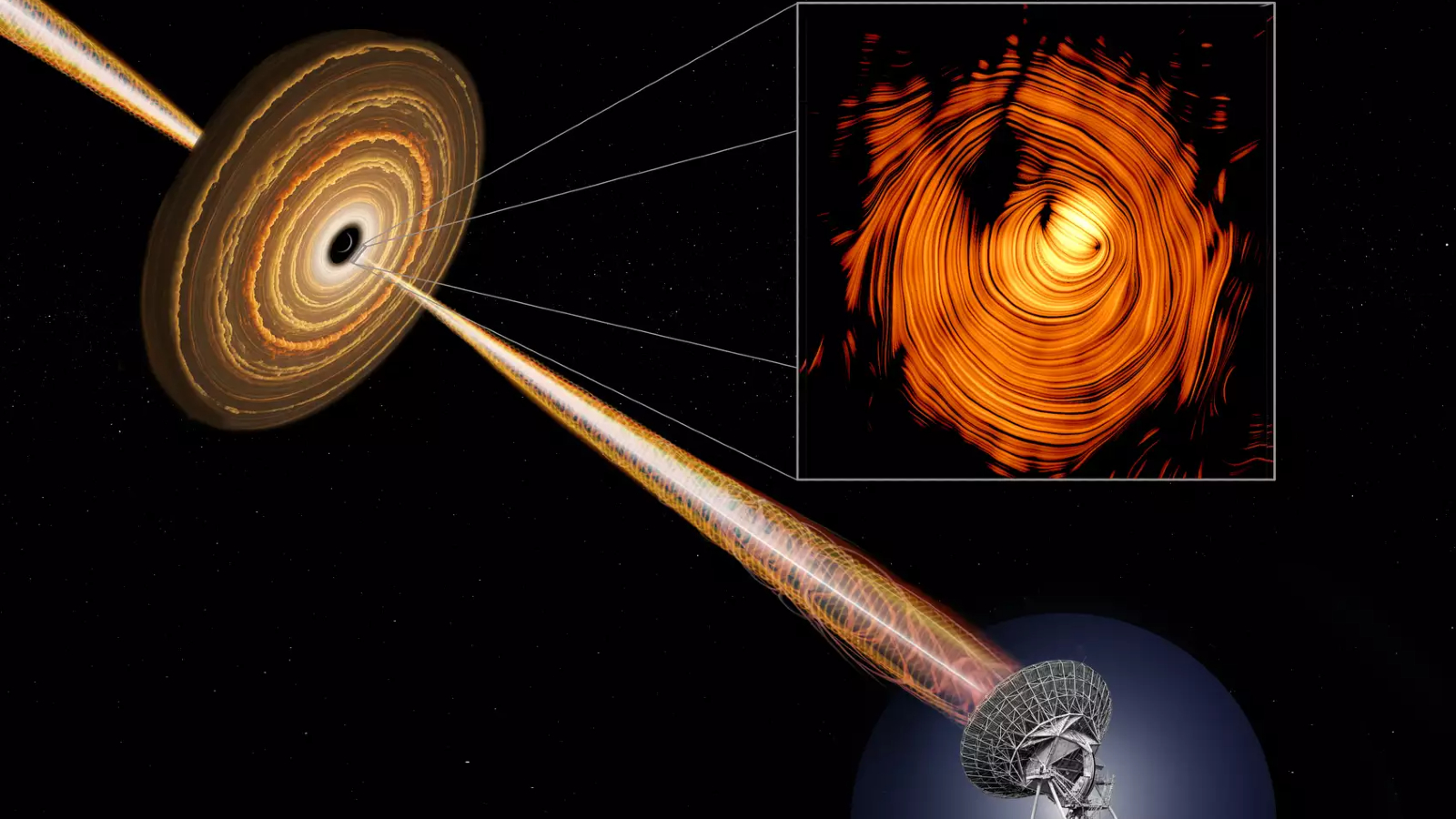Astronomers have snapped a stunning shot of the complex magnetic field of a gigantic energy jet, dubbed the “Eye of Sauron,” staring directly at us from across the cosmos. The incredible image, which took over 15 years to capture, also sheds light on the mysterious origin of neutrinos, ghostly particles that rarely interact with other matter.
The origin of this glowering cosmic eye is a blazar dubbed PKS 1424+240, located billions of light-years from Earth. A blazar is a type of quasar — a supermassive black hole at the heart of a distant galaxy that shoots out gigantic and superpowerful energy jets into space. These jets move at near light-speed and contain some of the highest concentrations of high-energy gamma rays and X-rays anywhere in the universe.
Blazars are unique because their energy jets are near-perfectly aligned with Earth, meaning their radiation hits our planet head-on, making them appear much brighter to us than most quasars and often causing them to outshine their home galaxies. In this photo, researchers have peered through one of PKS 1424+240’s “jet cones” using radio waves, allowing them to visualize the magnetic fields within the energy beam.
PKS 1424+240 was first discovered as a radio source in the 1970s and was later identified as a blazar in 1988. Subsequent research revealed that the black hole’s gigantic energy jets are pointed almost directly at us at an angle of less than 0.6 degrees. However, until now, scientists have been unable to map out these energy beams.
In a new study, published Aug. 12 in the journal Astronomy and Astrophysics, researchers unveiled the first clear image of PKS 1424+240 after stitching together 15 years’ worth of data collected by the National Radio Astronomy Observatory’s Very Long Baseline Array (VLBA), which combines the observing power of 10 radio dishes located in different U.S. states and territories.
“When we reconstructed the image, it looked absolutely stunning,” study lead author Yuri Kovalev, an astronomer at the Max Planck Institute for Radio Astronomy in Bonn, Germany, said in a statement. “We have never seen anything quite like it — a near-perfect toroidal magnetic field with a jet, pointing straight at us.”
Related: Supermassive black hole spotted 12.9 billion light-years from Earth — and it’s shooting a beam of energy right at us

The new image was only possible because of the jet’s near-perfect alignment with Earth, which amplifies its high-energy emissions thanks to the effects of special relativity — Einstein’s theory that the speed of an object is relative to the person observing it. Researchers estimate that this makes the jet around 30 times brighter than it otherwise would be.
The researchers named the new image the Eye of Sauron because of its resemblance to the symbol of the dark lord from J.R.R. Tolkien’s “The Lord of the Rings” series. This is not the first time scientists have named a discovery after this fictional entity: In recent years, a giant underwater volcano in the Indian Ocean and a new species of piranha in the Amazon River have also been named after the Eye of Sauron.
Understanding “ghost particles”
PKS 1424+240 has “long baffled astronomers” because it is the brightest known neutrino-emitting blazar of any blazar, researchers wrote in the statement.
Neutrinos, also known as “ghost particles,” are superfast, high-energy subatomic particles that rarely interact with normal matter. They are one of the most abundant particles in the universe, and experts predict that trillions of these phantom particles shoot through our bodies every second.
But despite being able to infrequently spot neutrinos using giant underwater detectors and inside particle accelerators on Earth, these particles are still shrouded in mystery, meaning scientists have to look to the cosmos for clues to their nature.
Visualizing the magnetic field controlling the jet has helped researchers see into the “heart” of the PKS 1424+240, and they now believe that the blazar’s own magnetic field accelerates protons to such high speeds that they become neutrinos, Live Science’s sister site Space.com reported.
However, more observations of similar jets are likely needed to unravel the mechanism of how this happens.
